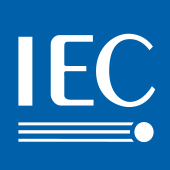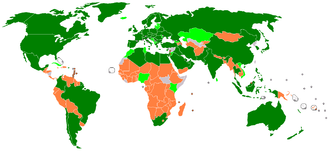International Electrotechnical Commission
The International Electrotechnical Commission (from the English I nternational E lectrotechnical C ommission [ ˌɪntəˈnæʃənəl ɪˌlɛktɹəˈtɛknɪkəl kəˈmɪʃən ], or IEC for short ) is an international standardization organization for standards in the field of electrical engineering and electronics based in Geneva . Some standards are developed together with the ISO ( International Organization for Standardization ).
history
The IEC was founded in 1906 and was initially located in London ; since 1948 the organization has been in Geneva . The IEC was instrumental in harmonizing standards for units of measurement , in particular Gauss , Hertz and Weber . A system of standards was also proposed first, the Giovanni Giorgi system, which ultimately became the SI , the International System of Units . In 1938 a multilingual international dictionary was published to standardize electrical engineering terms. The work continues, the International Electrotechnical Dictionary (IEV) remains an important task in the electrical and electronics industry.
task
The IEC statutes include all electrical engineering, including conversion and distribution of energy , electronics, magnetism and electromagnetism , electroacoustics , multimedia , telecommunications and medical technology as well as general disciplines such as technical vocabulary and symbols, electromagnetic compatibility , measurement technology and operating behavior , reliability , design and development, safety and the environment.
organization
As an association under Swiss law, the IEC is a non-profit, non-governmental organization. In addition to the General Secretariat in Geneva, there are four regional centers: for Asia in Singapore, for Latin America in Brazil, for North America in the USA and for the Pacific in Sydney.
In technical committees (TC; technical commitees ), subcommittees (SC; subcommittees ) and working groups (WG; working groups ) she develops international norms and standards for electrical engineering. The committees are led by the standardization management board (SMB ), which also determines the formation of new technical committees and their areas of responsibility. The SMB has set up technical advisory committees and application-oriented sector committees for overarching subject areas such as safety, environmental aspects or electromagnetic compatibility. The assessment of current and future technological developments as well as the market requirements for electrotechnical standardization work are carried out in special working groups of the Market Strategy Board (MSB) of the IEC. The Conformity Assessment Board (CAB) coordinates the activities of the four IEC conformity assessment systems IECEE, IECEx, IECQ and IECRE.
Work results / publications
IEC standards have number ranges between 60000 and 79999. Their titles are, for example, IEC 60417: Graphical Symbols for use on Equipment . The numbers of older IEC standards were converted in 1997 by adding 60,000 added, for example, was from the IEC 27 to IEC 60027 .
Standards that are developed jointly with ISO are given the prefixes of both organizations, such as in "ISO / IEC 7498-1: 1994, Open Systems Interconnection : Basic Reference Model ". The results of the work from ISO / IEC Joint Technical Committee 1 (ISO / IEC JTC1), which deals with standards in the field of information technology, are published under the common prefix of both organizations. Otherwise, jointly developed standards of both organizations are published in a number range starting with 80000. Here, however, only one of the two organizations is responsible for each part of a series of standards, for example in ISO 81714-1, IEC 81714-2, IEC 82045-1, IEC 82045-2.
In 2003, 491 new guidelines and standards were published. Among other things, the CISPR ( Comité International Spécial des Perturbations Radioélectriques ) emerged from the IEC.
membership
The IEC consists of members called national committees (NC). Each NC represents the national electrotechnical interests in the IEC. This includes manufacturers, suppliers, distributors and providers, consumers and users, all levels of government bodies, professional associations and trade associations as well as developers of national standards bodies. National committees are organized differently. Some NC only represent the public sector , some represent the public and private sectors, and some only represent the private. Around 90% of the employees who prepare IEC standards work in industry.
More than 80 countries are represented in the IEC, organized in 1442 working groups and commissions.
- Brazil - Comitê Brasileiro de Eletricidade, Eletrônica, Iluminação e Telecomunicações (Cobei)
- China - Standardization Administration of China (SAC)
- Denmark - Dansk Standard (DS)
- Germany - German Commission for Electrical, Electronic and Information Technologies (DKE)
- France - Union Technique de l'Electricité (UTE)
- United Kingdom - British Standards Institution (BSI)
- India - Bureau of Indian Standards (BIS)
- Italy - Comitato Elettrotecnico Italiano
- Japan - Japanese Industrial Standards Committee
- Canada - Standards Council of Canada
- Netherlands - Nederlands Elektrotechnisch Comité (NEC)
- Austria - Austrian Association for Electrical Engineering (OVE)
- Russia - Federal Agency for Technical Regulation and Metrology (ГОСТ)
- Sweden - SEK Svensk Elstandard (SEK)
- Switzerland - Swiss Electrotechnical Committee , Comité Electrotechnique Suisse (CES)
- Spain - Comite Nacional Español de la CEI
- South Africa - South African Bureau of Standards (SABS)
- USA - American National Standards Institute (ANSI)
Sub-organizations
- IECEE IEC System of Conformity Assessment Schemes for Electrotechnical Equipment and Components 'IEC system for conformity assessment systems for electrical equipment and components' , Geneva
- IECEx IEC System for Certification to Standards relating to equipment for use in Explosive Atmospheres 'IEC system for certification according to standards for equipment for use in explosive atmospheres' , Geneva
- IECQ IEC Quality Assessment System for Electronic Components ' IEC Quality Assessment System for Electronic Components ' , Geneva (formerly: IECQ-CECC)
See also
- International Electricity Congress
- The European organization comparable to the IEC is the European Committee for Electrotechnical Standardization (CENELEC).
Web links
- Official website (English)
- International Electrotechnical Vocabulary (IEV) IEV online (English)
- International Electrotechnical Vocabulary (IEV) IEV dictionary (German)
- IECEE
- IECEx
- IECQ
Individual evidence
- ↑ About the IEC> Who we are> Members Accessed January 7, 2020.
- ↑ Official website - What we do> Facts & figures . Accessed September 7, 2019.

